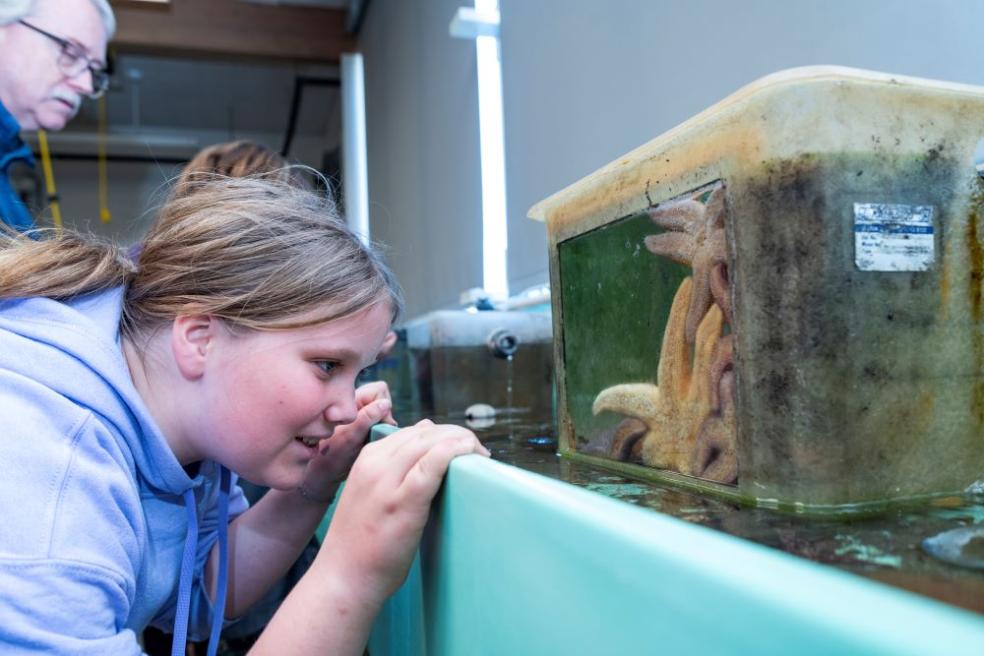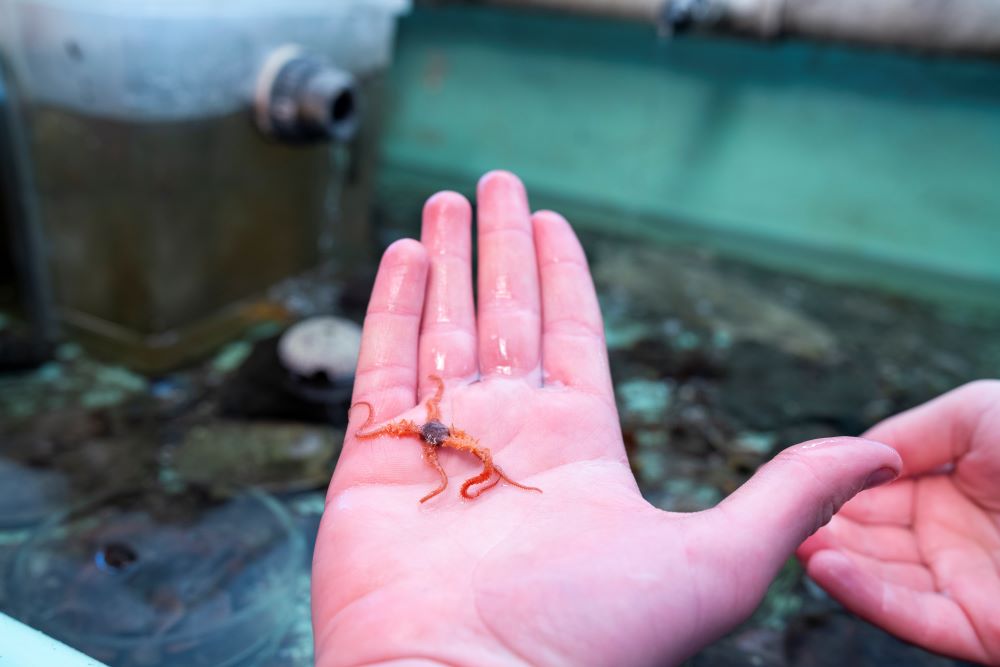
The research is in partnership with The Birch Aquarium at Scripps, the California Academy of Sciences, the Sunflower Star Laboratory, The Nature Conservancy, Omaha’s Henry Doorly Zoo and Aquarium, and more. Together, the researchers aim to reintroduce Pycnopodia helianthoides, aka the sunflower sea star, back into West Coast waters. Doing so would boost biodiversity and help restore kelp ecosystems, which naturally sequester millions of pounds of carbon each year.
Once common in the Pacific, sunflower sea stars are now functionally extinct in California, explains David Sinn, Wildlife instructor and Cal Poly Humboldt’s lead researcher on the study.

Roughly a decade ago, sea star populations along the West Coast were devastated by disease. Sea star wasting disease, which affects several different types of sea stars, a type of echinoderm, killed more than 90% of the sunflower sea stars, according to the National Oceanic and Atmospheric Association. It’s considered the largest marine disease outbreak recorded yet, killing billions.
Combined with the effects of climate change and warming waters, the keystone species is now listed as critically endangered by the International Union for Conservation of Nature. As a result, populations of purple urchins—a main food course of the sunflower sea star—have increased. The urchins have wreaked havoc on kelp ecosystems, leaving barrens in their wake.
Reintroducing the sea stars back into California waters requires researchers to raise them in captivity, explains Sinn. To better understand how to do that, Cal Poly Humboldt students, staff, and faculty from the Wildlife, Fisheries Biology, and Marine Biology programs designed a system to rear larval echinoderms—including sunflower stars and bat stars—and their prey, purple and red urchins.
This team recently finished design and construction of the system and has spawned bat stars and urchins at the University’s Telonicher Marine Lab. The efforts are supported by a $3,000 grant from the Sequoia Park Zoo’s conservation fund.
The system is so far successful, explains Marine Biology undergrad student Colbiey Pitt. Pitt is working closely with faculty including Sinn, Marine Biology Professor Sean Craig, and Fisheries Biology Professor Rafael Cuevas Uribe on the project. He will continue the research in his graduate studies under Craig.
The team hopes to begin working with sunflower stars by the end of the year.
While other project partners, including Friday Harbor Lab at the University of Washington, have successfully spawned and reared sunflower stars, researchers are still learning about the stars, sea star wasting disease, and more before any reintroduction into the wild is possible. The research conducted at Cal Poly Humboldt and throughout the West Coast will contribute to that understanding.
This research and program, Pitt says, is important to getting a near-extinct species back into California waters. “If we get this species back in the water, they will help curb urchin populations and hopefully allow for kelp restoration efforts to be more successful. This in turn would help re-establish certain fisheries such as oceanic salmon or rockfish and even some shellfish like Dungeness crab which all use kelp forests as nursery habitat.”
The effects of the research could be three-fold, Sinn explains. It could affect conservation efforts for a variety of echinoderms, mitigate the effects of climate change by restoring kelp forests, and it could be beneficial for aquaculture.
Aquaculture is part of a larger solution to solve human food issues on a global level, explains Sinn. “Wild fisheries are on the decline; aquaculture is going to be part of feeding humans well into the future.”
For Humboldt students like Pitt, the project also offers unparalleled opportunities to be involved in groundbreaking research.
“I don't believe I could've gotten this research experience as an undergrad elsewhere,” says Pitt. “The support from Sean, Rafael, and David has been super helpful and support from professors like them is what makes undergrad work at Humboldt possible.”
Humboldt researchers are also working with community members, including the Trinidad Rancheria Tribe, and local eighth graders at Northcoast Preparatory Academy, who recently visited the marine lab to learn about the sea star research.
“The field trip was a great opportunity for Northcoast Preparatory Academy students to connect with research they have learned and are curious about in real-time at Cal Poly Humboldt. It’s inspiring for them to know that people are working on the problems we've studied in class and that they could potentially be part of the solutions,” says Northcoast Preparatory Academy Science Teacher Sarah Burstein.
For more information, or to report a sunflower sea star sighting, contact the Humboldt Sea Star Team at seastars@humboldt.edu.